Identify, Tor.com! Are you still young enough to enjoy a Movie Rewatch of Great Nostalgia? I bet you are!
Today’s entry in the MRGN is that retro classic of 1976, Logan’s Run. It takes all the fun out of dying!
Previous entries can be found here. Please note that as with all films covered on the Nostalgia Rewatch, this post will be rife with spoilers for the film.
And now, the post!
So! Logan’s Run, boyeth and girleth, is a 1976 film starring Michael York as Logan 5, a law enforcement officer in a seemingly perfect futuristic city tasked with the duty to chase down and kill “Runners”, or those who try to escape the City, and doesn’t see anything wrong with that – until he becomes one himself.
I should mention at the outset that we’re cheating a little on this one, as Liz had not actually seen Logan’s Run before we watched it for the MRGN. Kate says she’s seen it, but remembered very little of it. We decided, though, to do the movie anyway, mostly because it had been requested so many times in the MRGN comments, and also because I, unlike my sisters, have vivid memories indeed of sitting down with my mother and watching it on TV, and being enthralled with what I would only later understand was the concept of post-apocalyptic dystopia.
Dystopian projections of the future were nothing new in science fiction cinema by the 1970s, of course. Not with predecessors like 1984 (both the Orwell novel from 1949 and its film adaptation in 1956), The Time Machine (the 1960 adaptation of H.G. Wells’ 1895 novel), and even all the way back to Fritz Lang’s classic Metropolis in 1927. But the 60s and 70s in particular seemed to have a special fondness for the dystopian trope, what with the popularity of films like the Planet of the Apes series, The Omega Man, A Clockwork Orange, THX 1138, Soylent Green, etc. Imagining all the myriad ways in which humans could thoroughly fuck up the future was very popular in the Cold War/Vietnam era, let’s just say. I can’t imagine why!
Logan’s Run is actually part of a subgenre within that subgenre: a future which initially disguises itself as a utopia, and is only revealed as dystopian as certain key elements become clear, taking a page from Aldous Huxley’s Brave New World (as have many others, both before and since 1976).
Or rather, it would have been, if some genius hadn’t decided to blow the twist by putting an overly explanatory title card at the beginning, cluing us in to the “dys” prefix of this particular –topia before we even got to see it. Ugh.
But then, Hollywood has a long history of not trusting in the intelligence of its audience to get what’s going on, especially in the realm of SF. (And it’s not just a 70s thing, either – they did the same thing with the opening of Dark City in 1998.) Whether I think this is a wise prejudice to hold or not tends to vary with whatever my cynicism threshold level is on any given day, but today I’m veering toward being annoyed with the decision to not let the movie itself tell the audience that the seemingly perfect utopia of the movie’s domed city is actually a giant death cult in disguise.
KATE: A spinning giant death cult, whee!
LIZ: Worst merry-go-round EVER.
This scene is, naturally, the most vivid of my memories of Logan’s Run. (Also, apparently, one of the most elaborate high-wire stunts ever put on film.) But then, as a kid, it’s probably hard to forget watching a scene where people voluntarily submit to being spun up into the air and blown up like the world’s most grisly popcorn air popper.
It’s even more viscerally affecting though, I think, watching it as an adult who is definitely past the City’s horrifyingly arbitrary cutoff date of thirty years old. I mean, shit, that’s not even half a lifetime, for most of us. What an unbelievable waste.
In this, the film is definitely taking a cutting potshot at the youth-worshipping culture that sprung up in the 20th century (and particularly in Hollywood), with the premise that the City’s hedonistic paradise can only be achieved by keeping the population limited to the young and the beautiful.
Also, in the 70s, “hedonistic paradise” was apparently conveyed by what I imagine it would look like if Walt Disney dropped acid, built a giant mall in Vegas, and then mandated a 24/7 disco toga party dress code for everyone in it.
LIZ: Seems legit.
KATE: No bras! No black people!
Suffice it to say, a film in which apparently the only person of color to survive the vaguely-alluded-to apocalypse is actually the voice of a homicidal robot is not winning any prizes for racial awareness. It’s not really going to win any sexual freedom awards either: despite making a token acknowledgment that homosexuality exists (by having a man show up on the “Circuit” Logan accesses while looking for a sexual partner), the film quickly assures us that our protagonist is not like that, as Michael York is quick to be all “nope” and switch to the pointedly much more palatable option of Jessica 6, played by Jenny Agutter.
I love Jenny Agutter (she’s fabulous in Call the Midwife), but needless to say, Agutter’s character in this film is not exactly a triumph for feminism, either. But hey, the movie’s kind of trying to be open-minded even if it mostly fails, so okay, fine, whatever, 70s proto-liberalism yaaaaay.
Anyway, the film’s plot gets underway when the computer/artificial intelligence (I guess? that is controlling the city? presumably?) decides it wants to know what the hell this “Sanctuary” place is that all these Runners think they’re going to, and make it go away, and commissions Michael York to infiltrate and destroy Sanctuary. It does this by taking away his remaining four years before his Lastday killin’ date, and making him a Runner himself.
LIZ: Guess not!
KATE: HAH-ha!
ME: Man, that is cold.
The use of the ancient Egyptian ankh as an emblem of the Runners is apropos considering it literally means “life”, which is pretty good as an antithesis to the whole kill-us-when-we’re-thirty mindset, because what the hell, future people. For further cultural flavoring, the law enforcement officers of the City are called “Sandmen”, which puts a nice ominous spin on “entity that puts you to sleep.” …Permanently. Hah.
And then blah blah blah Logan and Jessica almost die of cosmetic surgery (holy crap Farrah Fawcett was in this) and random orgy and feral rugrats and fishfarming murderbots, like you do, and finally escape the City to find that the fabled “Sanctuary” is, uh, this:
KATE: They were assholes.
ME: HTH!
We thought the DC ruins set work looked very impressive, actually. Especially in comparison to the stiff fakeness of the City. I suppose it’s much easier to realistically impose a look on a place that already exists than to realistically create a place out of whole cloth. In any case, the whole Washington, D.C. sequence was very Planet of the Apes, in a good way, and we enjoyed it in that particular way that acknowledges that teeny tiny part of you that just wants to see the world burn.
And then of course the big revelation was that OMG people can get old, encapsulated in the person of Peter Ustinov, who I suspect was much better stunt casting in 1976 than he is now, because sadly while he was much decorated and esteemed an actor while he was alive, his legacy has rather faded since then. I feel obscurely guilty that I don’t really know him outside of Googling him for the purposes of this article, even though I know I’ve seen several of the productions he was in.
LIZ: Ugh, why is he quoting such a terrible Broadway musical?
ME: Ah, jeez.
Then I had to explain that the Andrew Lloyd Webber version of “Cats” (a) didn’t come out until 1981, and (b) was based on a much older collection of poems by T.S. Eliot, so Ustinov was definitely quoting Eliot here and not the musical. And now I wonder if there’s a term for the phenomenon of later obnoxious interpretations of a thing retroactively killing any appreciation for other homages to the original thing.
And then, like so many SF film adaptations that don’t feel the need to be as holistically coherent as the novels they are frequently based upon, the ending of the film raises more questions than it answers:
First of all, that’s a very Asimovian approach to killing an AI with a simple paradox, so well done there, I guess, but then we were all like, okay, but, does that mean this AI has been controlling the city all this time? And if so, who built it and how did it get to this point? Was it in collusion with murderbot Box and its determination to replace “protein from the sea” with frozen Runners? Have the occupants of the City been Soylent Green-ing it up all this time? And, generally, just what the hell is the deal here?
We don’t know, because the film never tells us. Liz comments that this is a common (and frustrating) sin of movies of this era, in that they never seem to really explore the implications of the setting and premise they are using. Leaving some things to the imagination is fine up a point, of course, but come on. I wanna know more!
This led to a discussion in which we all concluded that this would be a great film to remake, in fact, not only for the chance at improved special effects, but also (hopefully) for a treatment of the story which would more fully address the whys and wherefores of the world the basic premise implies. And in fact there have been ongoing reports of attempts at a remake, though I will view them with appropriate skepticism until something more than vague rumors is acknowledged.
That said, we all agreed that there was a lovely old school classic SF feel to Logan’s Run which we think rather disappeared from science fiction and fantasy movies and TV from the 80s on. The way I think of it, the 1920s through the 1950s invented the most fundamental SF tropes, the 60s and 70s expanded them as far as they would go, and everything since then has been either a deconstruction, subversion, or simple continuation of same.
But this is very much a personal impression based on my own particular explorations of the speculative fiction world, so I do very sincerely invite people to come and fight me on that assertion in the comments, because I am perfectly happy to acknowledge that I don’t know everything about this and would love to learn more.
So tell me, tell me, tell me! What do you think of Logan’s Run? Or SF in the 70s? Or dystopian futures? Or Michael York’s inexplicably bothersome face? Or how a bunch of hedonists who never work for anything are all thin and beautiful instead of being in fat babychairs like in Wall-E? Whatever it is, I want to hear your thoughts!
In the meantime, please enjoy our Nostalgia Love to Reality Love 1-10 Scale of Awesomeness!
For Logan’s Run:
Nostalgia: 5, since I was the only one who really remembered it
Reality: 7.5, for a maddeningly incomplete and period-cheesy but still intriguing story that we wanna know more about.
And thus ends the MRGN for today, my chickies! Now go on and don’t subscribe to any giant whirligig death cults, and come back in two weeks for our next installment, yay!










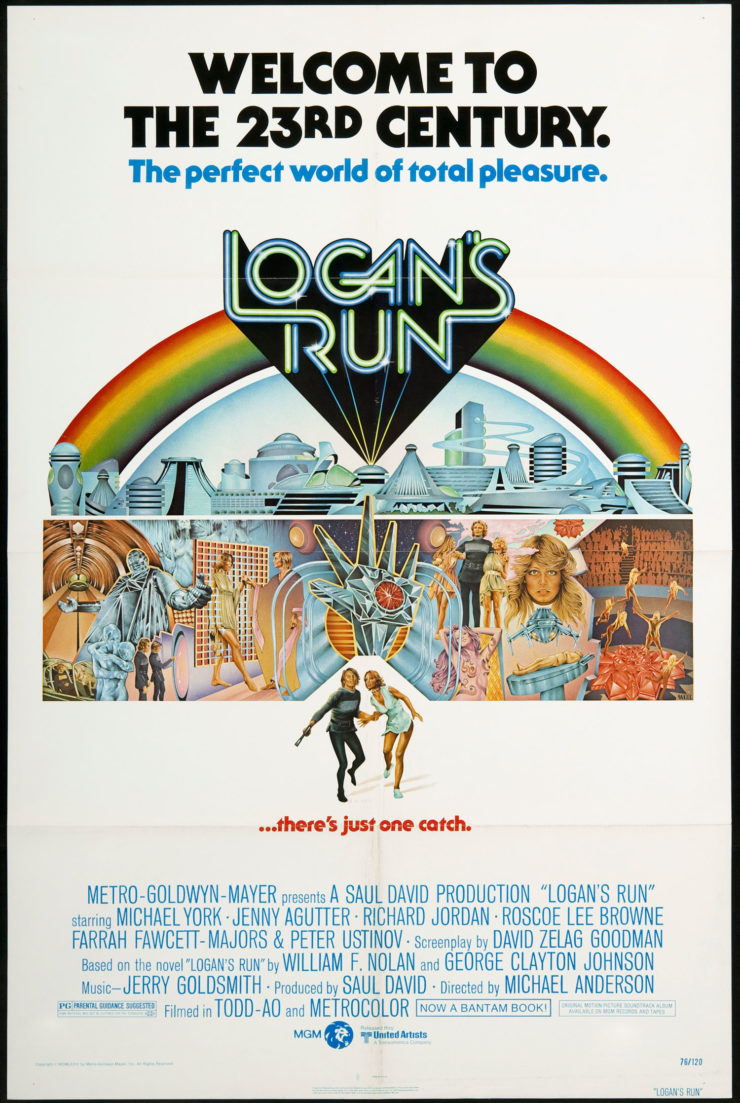
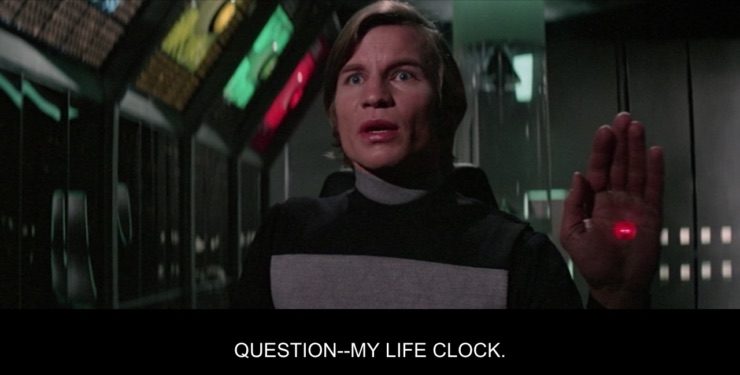

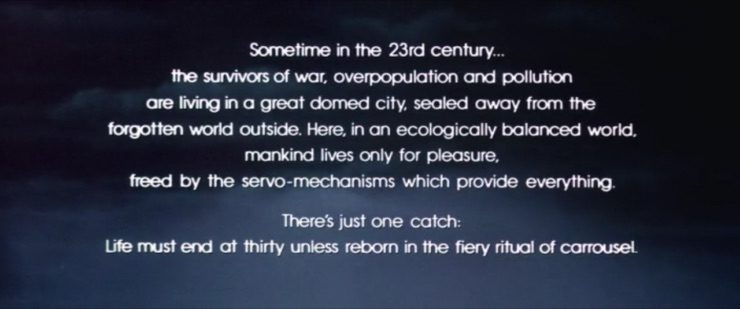

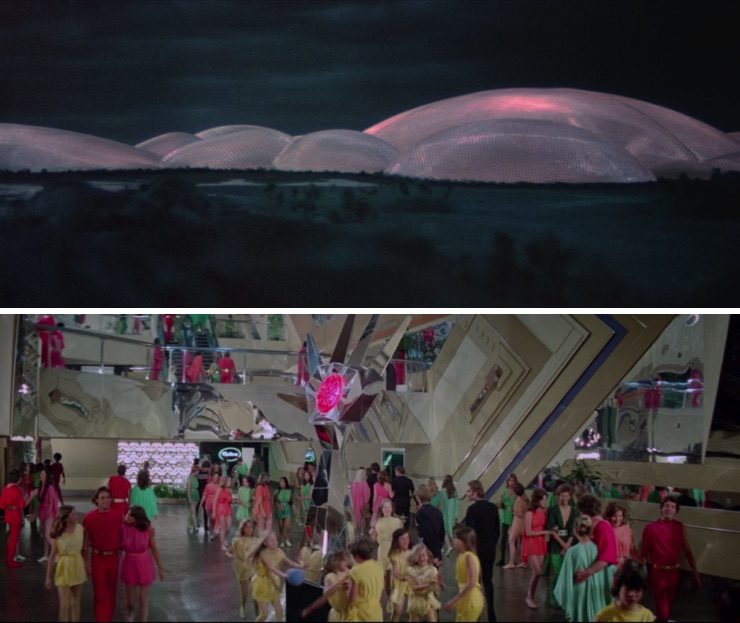
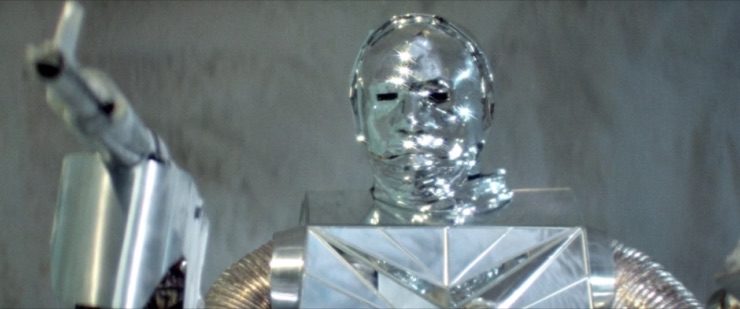
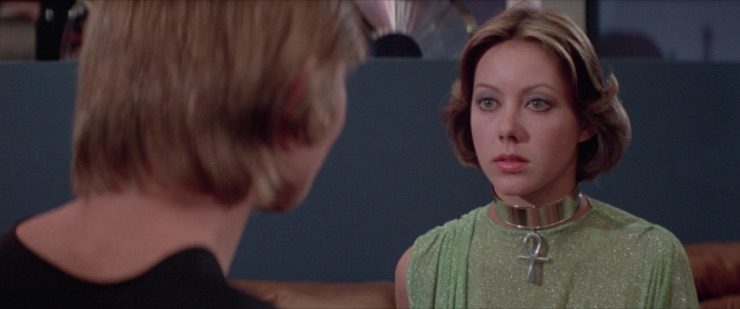
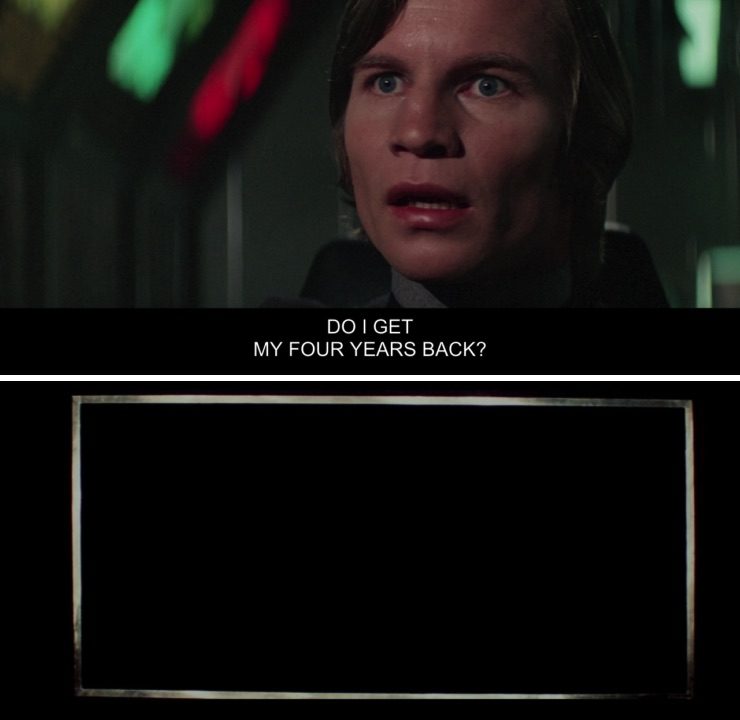
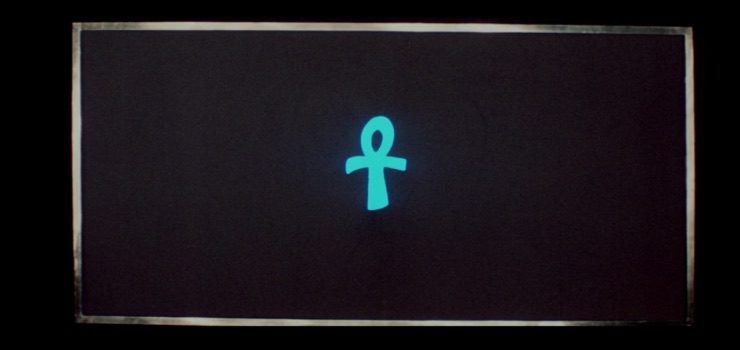
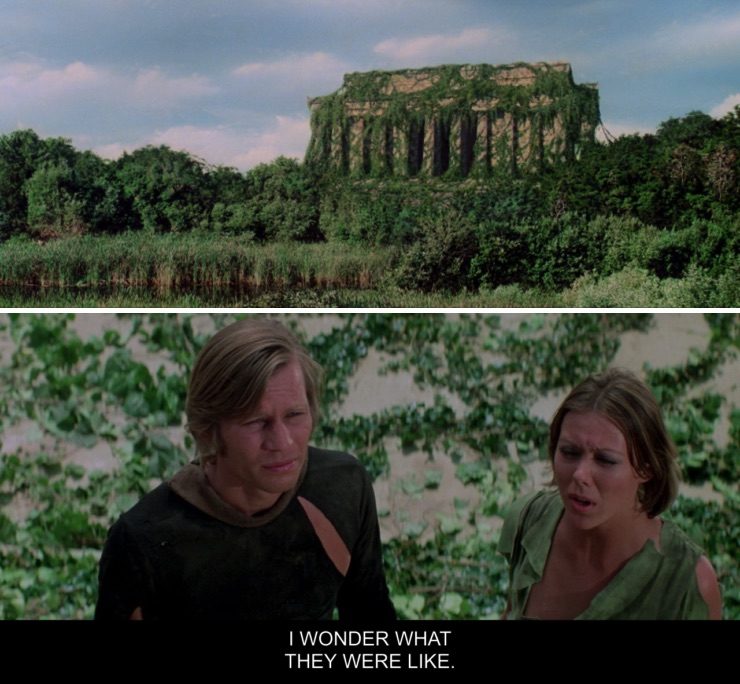
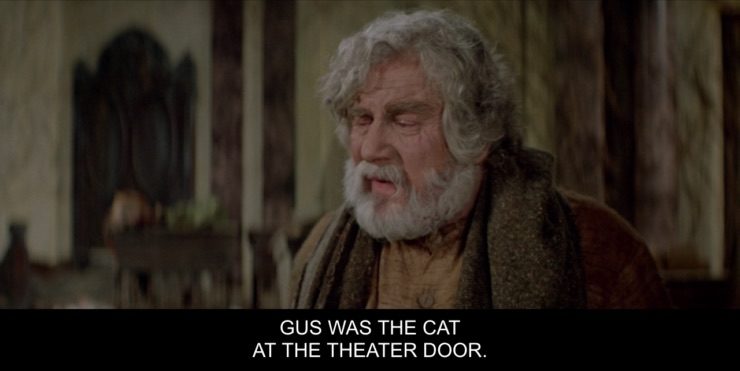
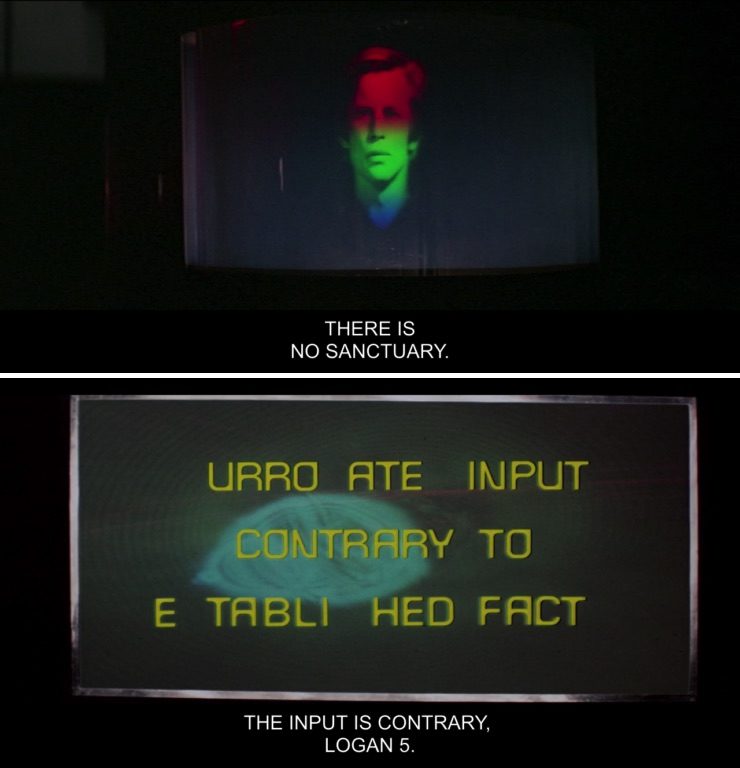
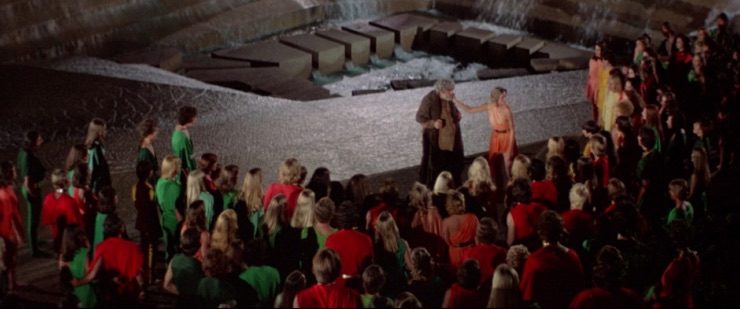
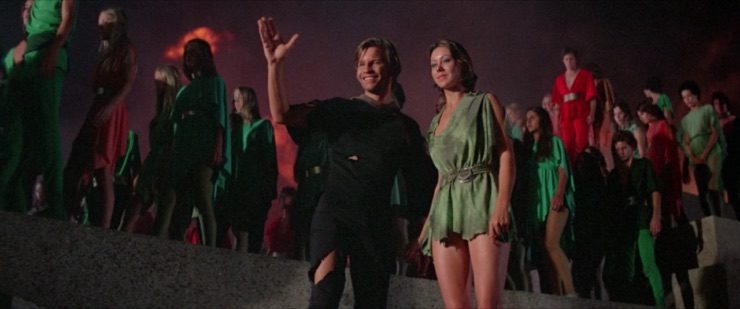
How could you gloss over the cyborg Box and his infinite food storage?
Check out my six-part look at the novel Logan’s Run and its five adaptations if you’ve got a spare few hours! http://www.weirdsciencedccomics.com/search/label/Logan's%20Run?&max-results=10
Thanks for doing this rewatch since Logan’s run is definitely a movie of great nostalgia for me. Saw it at some point in the early 1980s as a teenager (maybe on cable I cant remember now). My friends and I always used to joke about the crystal in the hand blinking on your 30th B-day… Did you see Free Enterprise? It had a great Logan’s Run reference. hopefully this is it: https://youtu.be/C8CjhP6WkjA
I always assumed the caretaker computer was separate from the protein harvesting robot at the end since the caretaker didnt know what sanctuary was… but now I am wondering if maybe the caretaker was faking ignorance to send more people to “sanctuary” and keep a steady food supply. Also, I think their utopian city was our local shopping mall…. anyone else remember malls. LOL
The 70s had some great dystopia movies/books… I think because everything seemed so bleak back then. no gas, no jobs, pollution everywhere, global nuclear war seemed probable.
I think I might agree with you that most of the novel scifi concepts were first introduced in the 20s – 50s… maybe even early 60s though. I taught a class on the short stories of PKD a few years ago and it seemed like 100s of subsequent movies/books were spin offs of his ideas. And the scifi writers of the 50s 60s all seemed to feed off each others ideas IMHO.
Do you by any chance remember the Logans Run TV Series?
It was released in 1977 and only lasted a year I think. I remember watching it as a kid and loved it. It had that Planet of the Apes series feel to it as well.
It starred Gregory Harrison as Logan, Heather Urich (Married to Robert Urich of Vegas or Spenser for hire fame) and Donald Moffat (of The Thing fame) who played a cyborg that went with the runners. They had this futuristic motor home/RV that they drove around in and got into adventures each week. I only remember bits and pieces of it and I think Farrah was also in one or two of the episodes.
Wow, now I’ve gotta see if I can find that on DVD or Blue Ray…
I think that Jesus of Nazareth was up next for our team as Herod and John the Baptist; York did a great speech at the end here that auditioned well for the Baptist role.
I was confused by the new Logan movie starring wolverine not Logan ..yep I am that old!
Haven’t read the book or seen the movie – but will have to fix that. Great entry Leigh!
Sorry, not sorry but i aint gettin’ off this merry-go-round. Wheee….!
I hate to be “that guy” but the book is such a richer experience, The youth society is a global one ( at one point I remember when Logan’s on the run he visits Egypt) and the age of “carousel” is 21 (I think Logan and Jessica are just 18) and the twist regarding Sanctuary and and his fellow Sandman Francis is dope!
I never understood why they needed Sandmen to chase down runners. Let them leave. One less body to take up resources, which is apparently why everyone (except the masters) dies at 30.
Tried to rewatch it recently but the bad special effects and overall cheesiness ruined it for me.
Thanks for the shout out for this. I really appreciated a couple points you made and ones that I often find a bit maddening when I hear people complaining about current material. Just like Logan’s Run, and movies like John Carter, I find that people often forget that these are foundation pieces. Their source material is old. I think you’re right that we need a good term for these foundation pieces. I remember seeing it and appreciating the material, and the concept, but… sure they took short buts that didn’t make sense.
As to the question about the runners… well remember a placid society is more easily handled… So they think they are going on Carousel for renewal, so they can get another 30 years… By disbelieving that, they are saying that Carousel isn’t the promised hope it is declared to be.
The original novel they all died at 21 rather than 30… Gee that sounds like about half the plots for bad YA novels these days.
And now I wonder if there’s a term for the phenomenon of later obnoxious interpretations of a thing retroactively killing any appreciation for other homages to the original thing.
Is this not known as the Jar-Jar Binks effect ?
I can be nostalgic about this because I saw it during its theatrical release, when I was 13. Back in those days before Star Wars changed everything a year later, Logan’s Run was pretty typical movie SF. Planet of the Apes, Westworld, Soylent Green, Silent Running… lots of movies with some cool skiffy stuff but making points about how lousy humanity is and how lousy the future will be. And then it was 1977, and what people expected from SF movies changed pretty dramatically.
Made me think of Silent Running, which you should add to your list.
About all I remember is those funky little robots and Bruce Dern’s crazy acting.
https://www.youtube.com/watch?v=R-OBV49gvmk
I haven’t been there in over a decade but concourse B in O’Hara airport always made me thing of Logan’s run.
You rode a slide way under and through colored neon lights. As you approached you could hear a voice that was unclear at first and finally resolved into something inane like “watch you step” or “now approaching” whatever, but as long as it was vague the feeling was mysterious and you could imagine that slide way taking you to the abyss.
“In this, the film is definitely taking a cutting potshot at the youth-worshipping culture that sprung up in the 20th century (and particularly in Hollywood), with the premise that the City’s hedonistic paradise can only be achieved by keeping the population limited to the young and the beautiful.”
I don’t think there is any coincidence that this movie is released when the leading edge of the Baby Boomers are hitting their 30s. Suddenly, maybe older folks do have some worth after all?
I have no idea why my mother let under ten me watch this when it came to television realizing what’s in it.
I remember this movie from some Sunday on cable and caught about half of the tv show when the Sci Fi channel used to marathon old tv shows like Wonder Woman the Incredible Hulk ect. gosh I miss that. I always thought the murder robot froze the sanctuary runners and kept them in storage not that the people of the city were eating them not enough inventory. It was creepy. The tv show was cute and added an extra demention to non- murdering androids. Suggested movies for later
Wargames, Krull, Cloak and DAgger, Conan’s, Ferris Bueller. Planet of the Apes old school.
@2, I remember an article, probably in Starlog that noted that they used a then famous mall for the internal city scenes. I can’t remember which, but the pictures above definitely remind of Oakwood Mall outside Chicago.
I saw this in the theater when it was first released, and it… um… kick-started my puberty. I’ve had a thing for Jenny Agutter ever since.
I would like to see this get remade, not just for the improved special effects, but in the hope that they would bring in the rest of the source material. In the books, there really is a Sanctuary. On Mars. Plus, as noted above, the idea that Logan’s friend is actually part of the Underground Railroad (so to speak). Maybe they could get Michael York to play the/an old man.
“Tried to rewatch it recently but the bad special effects and overall cheesiness ruined it for me.”
Same here… it sucked
The movie was shot in the Dallas Market Center, a cutting-edge shopping mall of the time. It was both a futuristic-looking location and an economical one, since shooting on location was cheaper than building a city from scratch.
As some of the other commenters have noted, the age of termination in the book was actually 21. This was apparently also the case in early drafts of the movie script, but the age was moved up to 30 to make casting easier. That’s almost exactly the opposite of what happens now, when existing fantasy characters are made younger because Hollywood is certain no one will go see a movie that stars actors over 27.
And I think we can rule out the idea that Box is in cahoots with whoever runs the city, since his speech about the original shipments ending abruptly and then being succeeded by humans implies pretty strongly that he had been created by whatever civilization preceded the current one, and was unaware of the changeover.
I also can’t help noticing, as I check the cast list, that just about all of the actors in the movie (the city residents, that is) are well into their 30s. Except for Jenny Agutter, at least.
Was I the only one, as a little boy, who fell instantly in love with Jenny Agutter?
This is one of my favorite science fiction films. It’s no Blade Runner, but it’s awesome.
OMG! I saw the scene with the robot in the ice cave as a kid, and for years I’ve been wondering what movie it was from!
And that’s the Ft Worth Water Gardens in the second-to-last screencap. A friend of mine worked security on the film.
“No bras!” And all the female extras were sewn into their costumes. And then out again for bathroom breaks.
Peter Ustinov does not appear until about 80 minutes into the film but still manages to steal the show.
“And now I wonder if there’s a term for the phenomenon of later obnoxious interpretations of a thing retroactively killing any appreciation for other homages to the original thing.”
Not exactly this, but the fact people can know of a newer or more recent version of a thing and thus not be aware of the older/original version is a cross between Popcultural Osmosis Failure and Adaptation Displacement, with some of the Weird Al Effect thrown in (except not involving a parody specifically). You’re welcome.
Ha, I saw this at the cinema on its original release. Loved it. I was mad for Richard Jordan in it. And it had Farrah Fawcett before Charlie’s Angels too. Good memories.
One of my favorite “oldied” I was “watching” it all through reading the post.Gotta find as copy to watch for real now.
As to the question:
“Or how a bunch of hedonists who never work for anything are all thin and beautiful instead of being in fat babychairs like in Wall-E?”
Every bit of their ultra sheltered lives that we see are tightly regulated. I’m thinking that their diet was tightly controlled too. I don’t remember if there was a reference to that in the film or not, but…
I liked this movie enough to name my middle son “Logan Smith”, because my wife wouldn’t go for “Logan Six”…, even as a little kid he was more of a “Runner” than a Sandman, yea, I’m a geek….
Box isn’t sending the protein back, you see the people frozen, and if I remember correctly, only a couple of hundred people are “missing” according to the AI…I remember thinking that Logan “Captain Kirk”ed the AI, although not on purpose
big Jenny Agutter crush here too….
@22: Watching Jenny Agutter in this movie was an important moment in my life as a young boy. To this day, I can’t remember if there was a nude scene or it was just the costume that made such an impact.
Hi 31 Theo16, I saw this on DVD a few years back, and it was a brief nude scene. Did not make much sense as part of the story as I recall, but I think the intention was simply to provide some titillation for those watching the movie when it first came out. Overall I thought the movie was better than I remembered it (oh the joy of lowered expectations).
I’m fascinated that anyone could believe there’s a way to fix this mess. The novel was built on a dumb premise (the sort of idea that mundane current authors writing their first SF come up with and think they’re so original); the movie made it worse. (Cinefantastique Quarterly headlined their review “The SF Boom Starts with a Bomb”.) And I was old enough to be cynical about Agutter rather than taken; I thought she was wooden in both this and the next thing I saw her in (Equus), which made me wonder whether she had any talent beyond peeling on-camera. Apparently she did; she has a respectable list of credits leading up to appearing as a member of the unbelievably stupid supervisors in the Marvel Comics Universe movies. It’s interesting to read people’s first reactions to her, as Farrah Fawcett was the mid-70’s equivalent of a pinup girl.
Regarding some of the unanswered questions… The film intentionally implies a decay occurring in the city. When they go to the outskirts known as Cathedral, Logan notes that several areas of the city are no longer used, and we see the place is a mess occupied by children (gangs). Later, when they have escaped the main city, they find themselves in a section which once was used to cull their food sources from the ocean. This connects with Box and his story about the regular food stopping and the Runners taking their place. The whole system is steadily falling apart, right down to the Carroussel (sic) not renewing any souls. This is consistent with the novel. The TV series has a shadow council of old men running things, which is a nice touch, but the film and book have a computer running everything and steadily going insane–hence the final, and rather ridiculous, collapse at the end.
We learn that, black uniform or no, Logan is a Good Guy when dials up Jessica on the circuit only to find she doesn’t want to have sex. Instead of getting annoyed – as he would be justified in doing – he makes her tea and listens to her problems, which also gives the audience some necessary explanations.
I watched the film again today since tomorrow is my 30th birthday and it felt appropriate to the occasion!
Regarding “racial awareness” or imo how the world outside of the Hollywood bubble actually looks like. If you pause, zoom in or look at the many behind the scenes film and stills you will see quite a few black people in fact Ive seen some deleted footage and their were black people right in the front etc. But when you watch the film its like the editor and or most likely the studio actively edits them out even in wide or long shots you see the black extras but only for a split second at most. Ive also read and heard stories of some who were colored extras in the film who were dismayed to see the final cut. More shocking is the 0 number of any Asians as well, as the planets ethnic majority by a wide margin NOT having any Asians in the world is really stunning. But that’s the US of A for you and sadly not much has changed since Logan’s Run film and ethnically wise now we just have either all white or all black, Latino or Asian themed or vice versa and the worst is the “token” black, Latino or Asian actor in most if not all US media.
I loved Logan’s Run, although I don’t know if it’d stand up to a rewatch for me. Jenny Agutter wasn’t just a formative moment for *boys*, and I feel that Michael York was the definitive 70’s lust object for young queer women who hadn’t yet figured out what was going on, similar to the 80s’ Johnny Depp, and Bieber today.
Absolutely loved the TV show, though, and I wonder if it’s one of those rare examples of the TV show surpassing the film. I’ll have to check them both out again.
@18, @22,
I think all straight male humans from puberty fell in lust with Jenny Agutter.
———-
The people in the novel weren’t terminated; they were recalled, and resurrected in new, young bodies.
Logan’s Run deleted scenes:
https://www.youtube.com/watch?v=MLwEzmRC_0w&list=PLkjrUu7zufJeZTJRcJgtdrm9jdK9lzeE7
Jenny Agutter? It was all about Michael York for me. Little did pre-teen queer me realize that Logan would be the first of many crushes on uncanny-valley boys with tight ripped clothes, and my own black and gray aesthetic. In my headcanon, Logandidn’t swipe left on the guy in the Circuit.
Well, the phrases “Don’t trust anyone over thirty” and “it does not compute” ring a bell? And the cats, nine lives. Interesting.